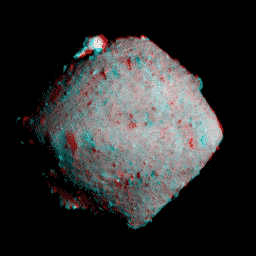Jason Davis • Jul 11, 2018
New goodies from asteroid Ryugu!
Hayabusa2 arrived at asteroid Ryugu back on June 27. Since then, it has been holding at a distance of 20 kilometers while flight controllers back on Earth check out its instruments. At the end of July, the spacecraft will start descending to a height of just 5 kilometers for medium-altitude observations.
The project has been quiet for a couple weeks, but today, JAXA released some new goodies! First, two new global views, the second of which really brings the bright object at the north pole into focus:


And here's a fancy rotation video! Get out your red-and-blue 3-D glasses for this one:

The raw file is a little small, so here's a blown-up version:
Finally, over at unmannedspaceflight.com, Roman Tkachenko used the new data to make an updated shape model of Ryugu.
"It's not perfect, but it's better than nothing," he writes. (Personally, I think it's pretty awesome.)
Support our core enterprises
Your support powers our mission to explore worlds, find life, and defend Earth. You make all the difference when you make a gift. Give today!
Donate

 Explore Worlds
Explore Worlds Find Life
Find Life Defend Earth
Defend Earth

